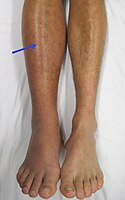
Photo from wikipedia
BACKGROUND spinal cord stimulation (SCS) is a neuromodulation process to treat neuropathic pain, initially developed on tonic paresthesia-based stimulation. In the last decade, three major paresthesia-free SCS have emerged. Several… Click to show full abstract
BACKGROUND spinal cord stimulation (SCS) is a neuromodulation process to treat neuropathic pain, initially developed on tonic paresthesia-based stimulation. In the last decade, three major paresthesia-free SCS have emerged. Several studies tend to show their superiority over tonic stimulation. OBJECTIVE We summarize the current data on SCS efficacy and patients' preferences. METHOD and population: we selected studies from the last decade to clarify whether the different paresthesia-free SCS are superior to tonic or not and for which SCS the patient has a preference. Studies selection was focused on a failed back surgery syndrome (FBSS) predominant population. RESULTS SCS is an effective way to treat intractable neuropathic pain of the limbs1,2 and back 1,2,3, compared to conventional medical management and reoperation. Paresthesia-free SCS as burst, high density (HD) and 10KHz frequency are equal to tonic SCS in some studies and superior in most. Patient's preferences analysis shows a clear trend toward paresthesia-free SCS. CONCLUSION Recent studies tend to show superiority of paresthesia-free SCS compared to tonic SCS and those results are corroborated by a patients' preferences analysis. Taking these data into account should motivate physicians to opt for multi-modal capable devices before implanting SCS.
Journal Title: World neurosurgery
Year Published: 2020
Link to full text (if available)
Share on Social Media: Sign Up to like & get
recommendations!